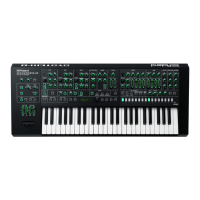22
Making System Settings (SYSTEM Setting Screen)
Menu
[SHIFT]+cursor [
K
] [
J
]
Parameter
Cursor [
K
] [
J
]
Value
[VALUE] knob
Explanation
PEDAL
HoldPolarity STD, RVS
Selects the polarity of the pedals.
Depending on the model of pedal, the result of depressing or
releasing the pedal might be the opposite of what you expect. If
so, choose the “RVS” setting. If you’re using a Roland pedal (that
has no polarity switch), choose the “STD” setting.
Exp Polarity STD, RVS
SOUND
Local Sw
OFF
ON
Enables/disables the connection between the controller section
(keyboard, pitch bend/modulation lever, wheels, panel knobs and
buttons, pedals, etc.) and the internal sound engine.
Normally you should leave this “ON.”
SURFACE
Choose “SURFACE” if you want to use operations on the SYSTEM-8
to only control an external sound module. The sound engine of
the SYSTEM-8 does not produce sound.
Boost Mode OFF, ON Turning this ON boosts the output level of the OUTPUT jacks.
OutputGain -12dB–0dB–+12dB Adjusts the SYSTEM-8’s overall output gain.
SYNC
Patch Tempo OFF, ON
If this is “ON,” the tempo setting of the patch is used. In this case,
the [TEMPO] knob changes the patch tempo.
If this is “OFF,” the system tempo setting is used. In this case, the
[TEMPO] knob changes the system tempo.
TempoSync AUTO, MIDI, USB, INT
Species the tempo source.
If this is set to “AU TO,” the tempo automatically synchronizes to
MIDI clock if MIDI clock is input via the MIDI IN connector or the
USB port.
If this is set to “INT,” the tempo specied on the SYSTEM-8 itself is
used.
Rx StartStop OFF, ON
Species whether step sequencer start/stop is controlled from
an external device (ON) or is not controlled (OFF) when the SYSTEM-8
is synchronized to an external MIDI clock.
Sync Output OFF, ON
Species whether clock, start, and stop messages are transmitted
to another device (ON) or are not transmitted (OFF).
MIDI
Device ID 17–32
When transmitting and receiving system exclusive messages, the
device ID numbers of both devices must match.
Remote Kbd OFF, ON
Turn this “ON” if you’re using an external MIDI keyboard instead of
the SYSTEM-8’s keyboard. In this case, the MIDI transmit channel
of your external MIDI keyboard does not matter. Normally, this can
be left at “OFF.”
* If you want to control the arpeggiator from an external MIDI
device, turn this “ON.”
Omni Mode OFF, ON
If this is ON, MIDI messages of all channels are received (valid only
in patch mode).
The MIDI transmit channel is either the Patch Ch (in patch mode)
or the Upper Ch and Lower Ch (in performance mode).
Patch Ch 1–16 Species the MIDI transmit/receive channel for patch mode.
Perf Ch OFF, 1–16
Species the MIDI transmit/receive channel used to select
performances.
Upper Ch 1–16 Species the transmit/receive channel of the upper part.
Lower Ch 1–16 Species the transmit/receive channel of the lower part.

